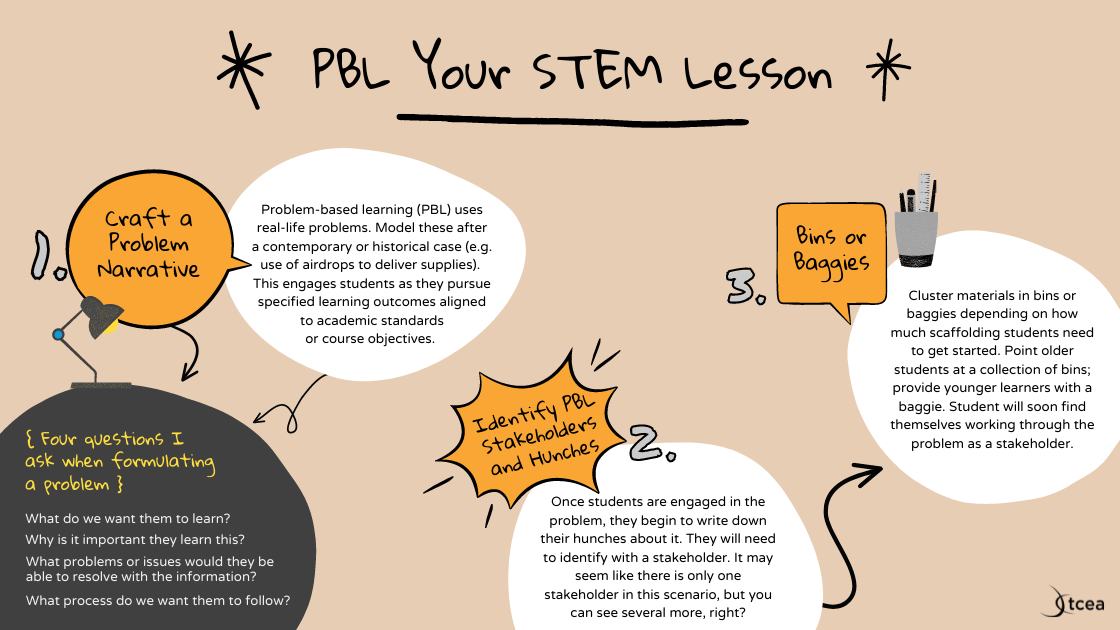Looking for exciting ways to engage your students? Combine what you know of Do It Yourself (DIY) STEM activities with project-based learning (PBL). In this blog entry, we’ll explore some great STEM ideas and then blend those into an engaging problem. Before we do that, allow me to introduce you to two book authors.
Introducing Simple Steam
Watching webinars can be a bit tedious. But I didn’t feel that way at all as I hung on every word of one speaker. As I struggled to multi-task, balancing work projects, I listened. What hooked me? The exciting possibility that STEM need not be complex. Wouldn’t that be an amazing possibility?
The webinar speaker referenced Debby Mitchell and Marnie Forestieri’s book Simple Steam: 50+ Science Technology Engineering Art and Math Activities for Ages 3 to 6. In the book, there are a variety of STEM projects geared for younger students. As I read about them, it occurred to me there was a road map to making them even more engaging.
Creating Engaging Learning
To create engaging learning opportunities, you can take advantage of many strategies. Engaged learning, research shows, increases their attention and focus. One engagement strategy involves leading dynamic discussions. John Hattie, oft-cited for Visible Learning, found classroom discussion quite important because it has an effect size that exceeds the “hinge point.” The hinge point refers to a students’ year of growth in the same amount of time. With a 0.82 effect size, a student has the potential of two years academic growth in half the time. All this from “meaningful classroom discussion,” says Maggie Bruski.
The question is, “How do YOU craft engaging classroom discussions?” The answer is that you PBL the dickens out of them.
PBLing Your STEM Lesson
Let’s examine how this might happen. We’ll rely on Mitchell and Forestieri’s book examples to start. The steps are straightforward:
Step 1: Craft a Problem Narrative
Problem-based learning (PBL) uses real-life problems. Model these after a contemporary or historical case (e.g. use of airdrops to deliver supplies). This engages students as they pursue specified learning outcomes aligned to academic standards or course objectives. Four questions I ask when formulating a problem include:
- What do we want them to learn?
- Why is it important they learn this?
- What problems or issues would they be able to resolve with the information?
- What process do we want them to follow?
Example:
In Simple STEAM, one project involves students learning key concepts about air resistance, force, gravity, and mass. A potential problem narrative go this way:
“Help us please! Without the vaccines in those crates, people will die of the infection.” Five operatives race up the stairs. They have a difficult task ahead of them and everything hinges on their work. The fire is spreading, too fast to stop, and forcing them up. The arsonists have blocked the way down. City fire and police are too overwhelmed to help. They reach the roof of the building, a few doctors and nurses milling around in panic.
The last cases of the anti-virus wait for helicopter pickup, but no helicopters are coming. They must think up a different way to get the crates of vaccine down from the skyscraper. But how? Number Three thumbs the mic on the team talkie to contact the team on the ground.
Then, Number One sees some supply closets. Desperate hope rises as she thinks. Number Two smiles. “Then, it falls, a flower on the wind.” They get to work.
Step 2: Identify PBL Stakeholders and Hunches
 Once students are engaged in the problem, they begin to write down their hunches about it. They will need to identify with a stakeholder. It may seem like there is only one stakeholder in this scenario, but you can see several more, right?
Once students are engaged in the problem, they begin to write down their hunches about it. They will need to identify with a stakeholder. It may seem like there is only one stakeholder in this scenario, but you can see several more, right?
This is an important action. After introducing the problem, it determines what happens next. You can say to students the following in regards to the stakeholders in the problem:
“To help them, let’s share what our hunches are, that is, our best guesses about three things. The first is this situation. The second is what we know based on a reading of the text. The third is what we need to know to help the person/people in this situation. What guesses can we make about what is happening in the story?”
We want to collect these hunches so that all students can see them, then move to asking questions. The focus of questions is to identify other questions about what we know and what we need to know to help the stakeholders. One approach for accomplishing this is the use of a KWHL chart:
- Know – What do we know based on our reading of the problem? (K)
- What – What do we want to know about this? (W)
- How – How are we going to find this out? (H)
- Learned – And, after the activity has moved on, what have we learned about this problem?
Inquiry and investigation builds a basis for students to design a solution product.
Step 3: Bins or Baggies
Cluster materials in bins or baggies depending on how much scaffolding students need to get started. Point older students at a collection of bins; provide younger learners with a baggie. Student will soon find themselves working through the problem as a stakeholder.
Your job as the teacher is to act as a guide as students explore the issues. Their job will involve formulating questions, conducting research, and making observations. They will then engage in rapid prototyping (solution development and testing). In the end, they will recommend a solution.
Example:
Students have several options to solve this problem. You can steer them in one direction (the use of parachutes). Make materials available such as a plastic grocery bag, string, and various “crates.” These could be multi-sized plastic containers with a lid so you can adjust item quantity. More items result in a heavier weight. Depending on the age, students could figure out what their parachutes can best support.
Technology Connection
As students design their parachute, have them document the results. This can involve pictures and video. After each test, students can chart the rates of descent in seconds for each of the different objects. Then test their solutions against a “standard” set of objects to see if they work. Have students report their observations via Seesaw. Set up tests using green screen technology to simulate a towering inferno or news reports from the scene. Students can present alternative news perspectives. This could involve arsonists or virus-infected individuals waiting for the cure.
PBL Your STEM Projects
As you can see, PBLing your STEM project involves some clever storytelling. You can blend various technologies to deepen the fiction and the storytelling.

